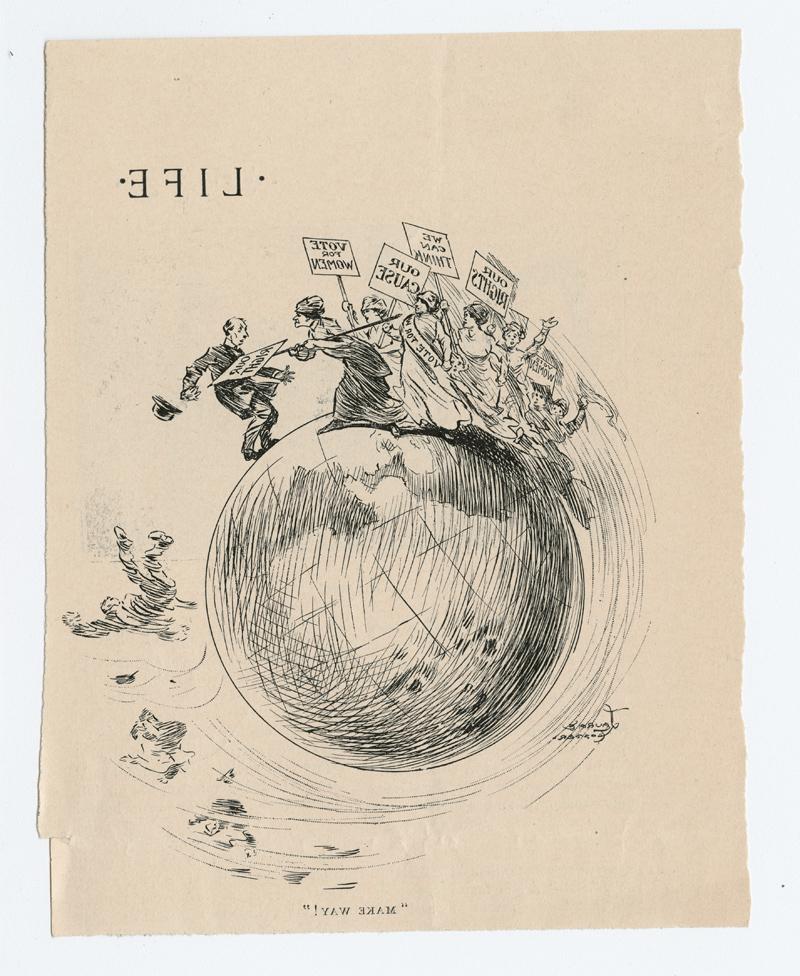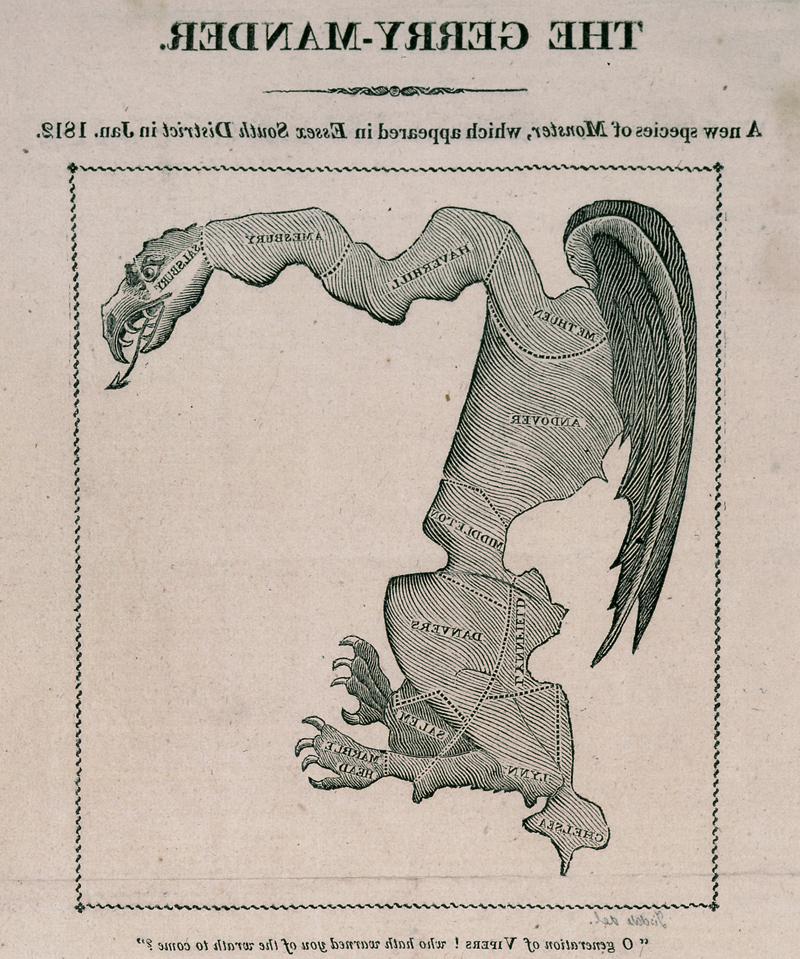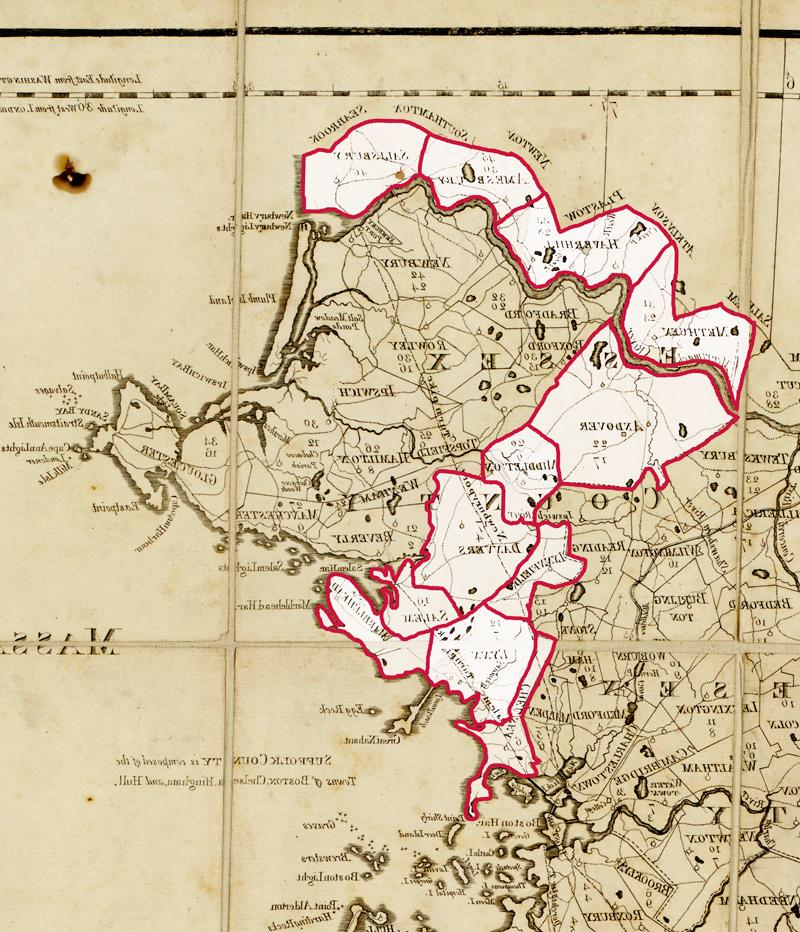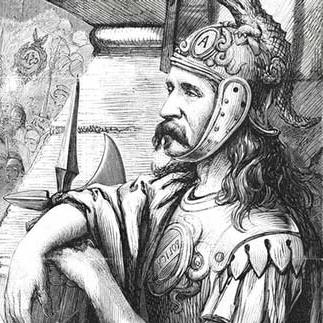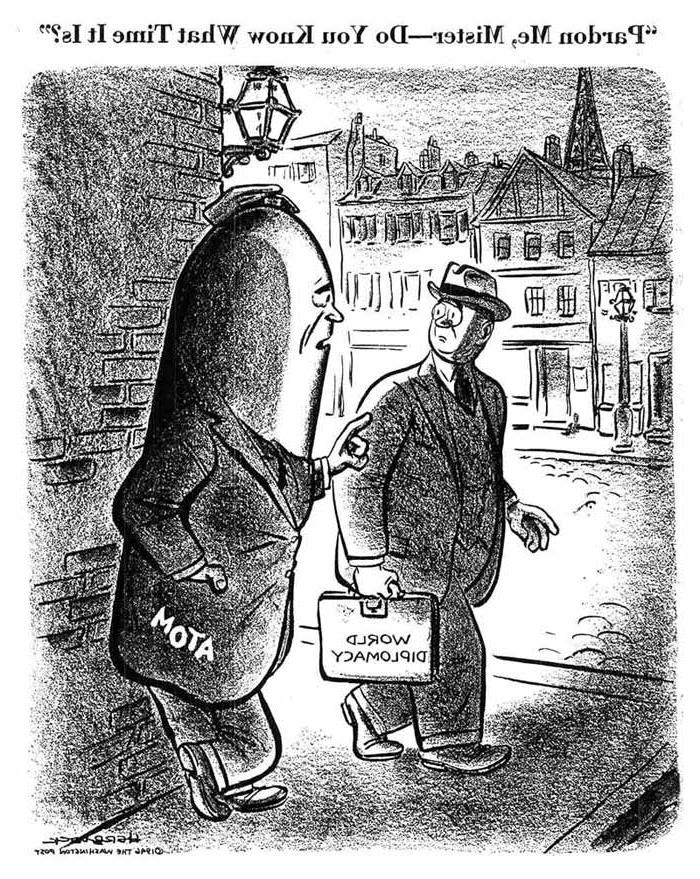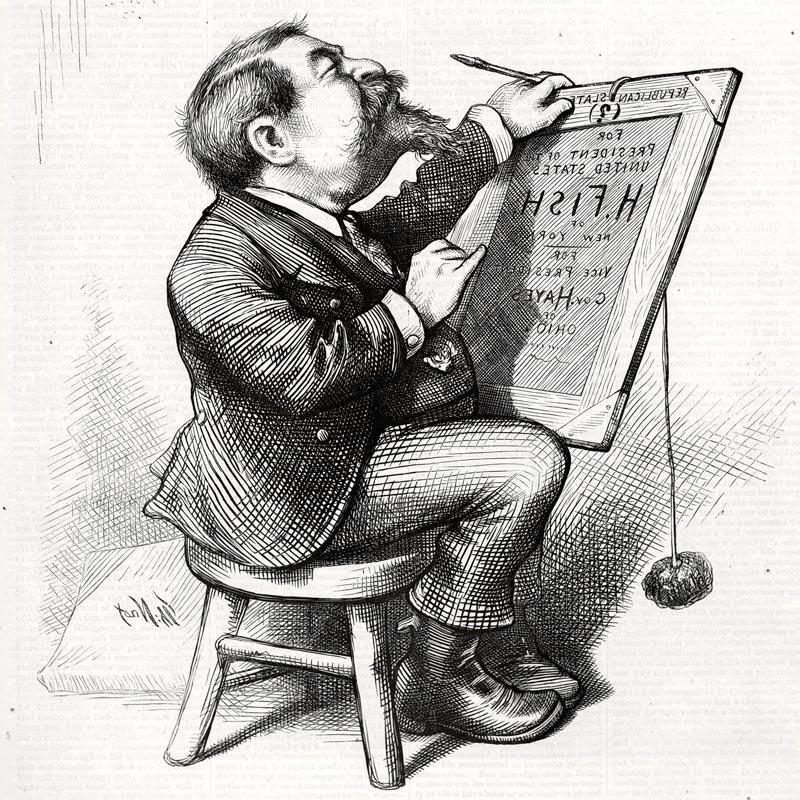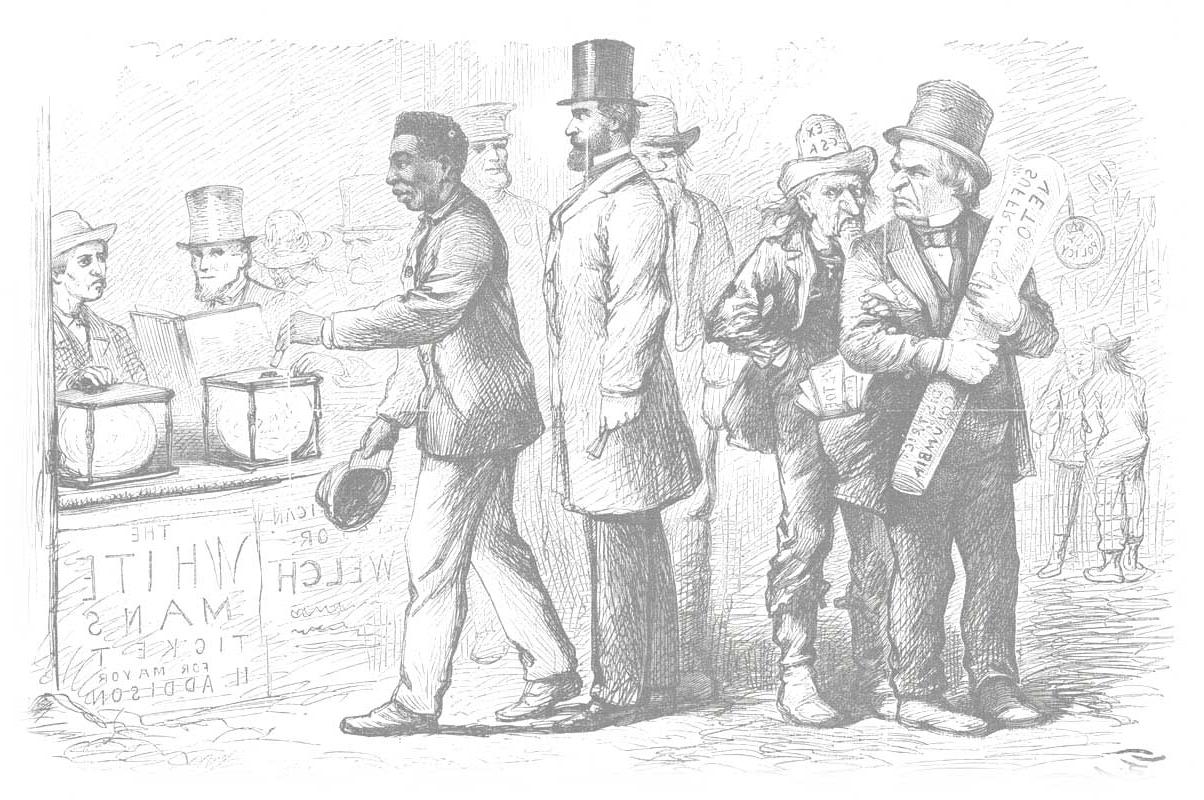
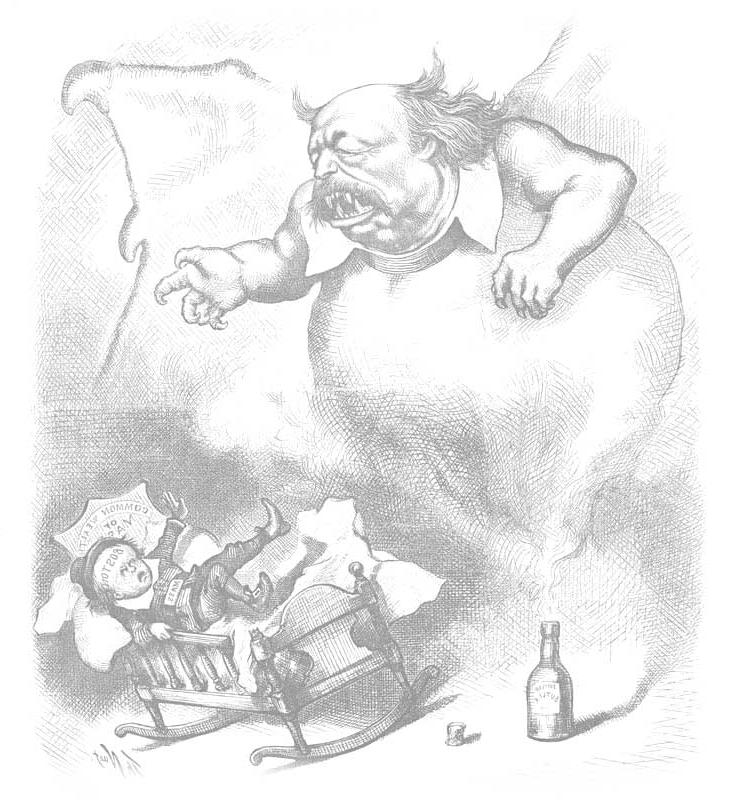


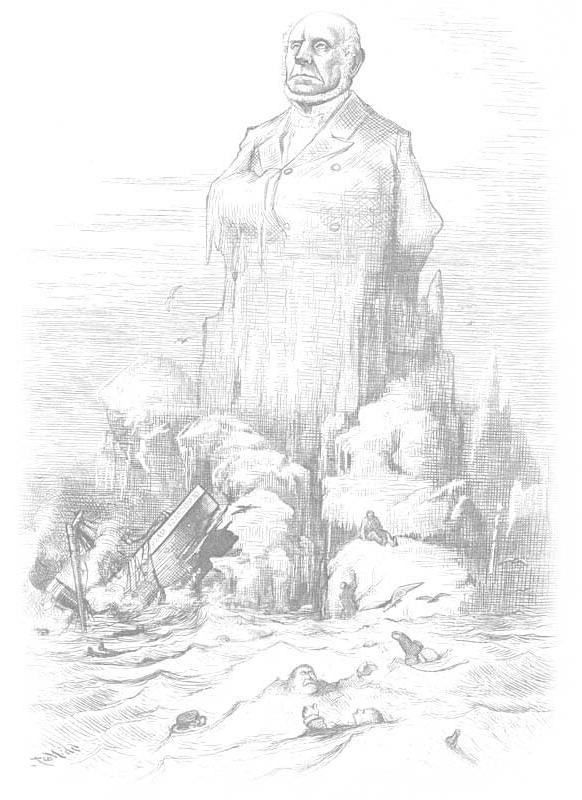
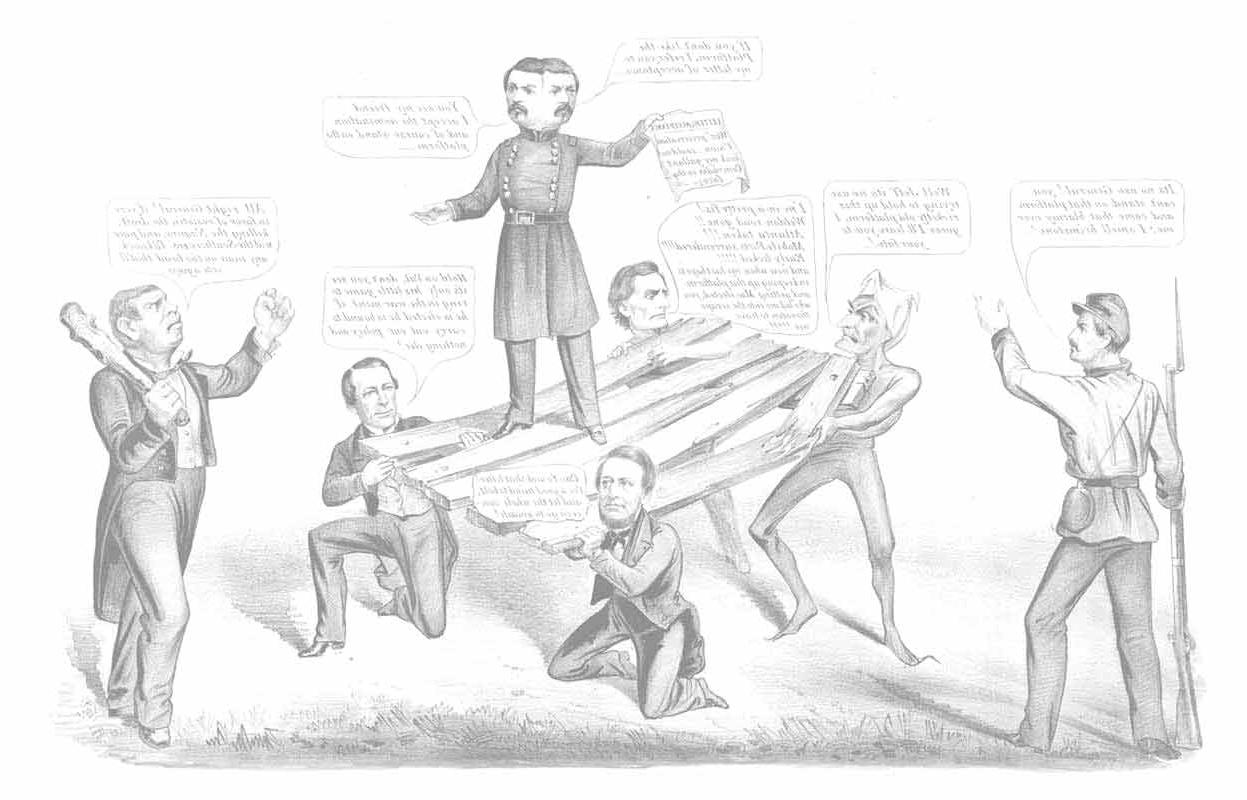
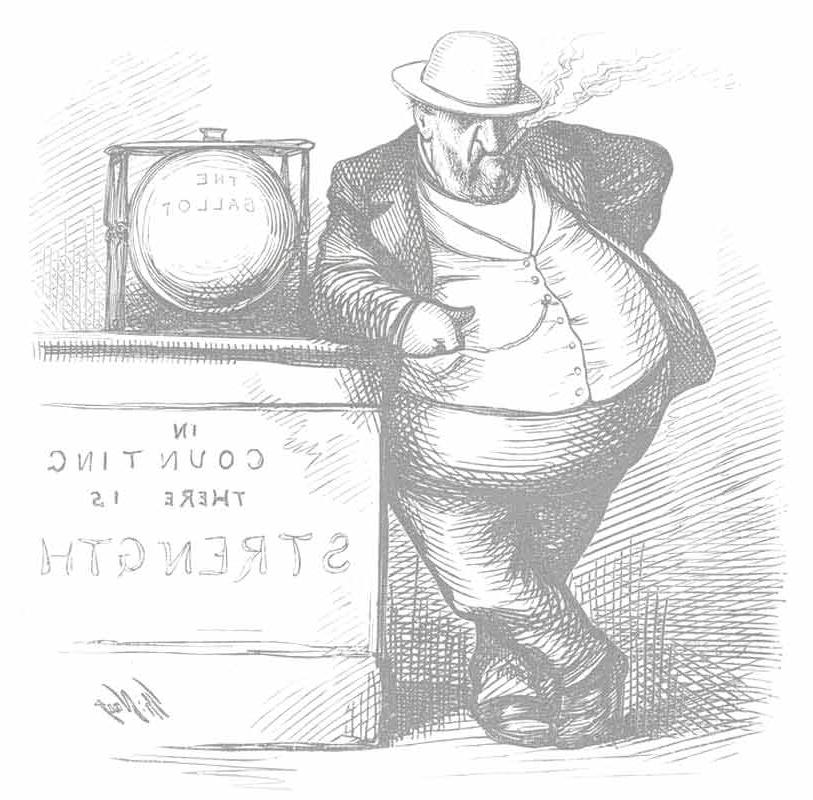
Political cartoons have long served to provoke public debate, illustrating opinions of the day for the masses. From early in the 19th century, arguments over voting rights—who votes and who counts the votes—have been depicted in cartoons, 特别是在南北战争前,插图报纸和杂志在全国范围内发行.
The 19th-century ballot box was a hand-blown glass bowl contained in a frame to make voting “transparent.” It was an attempt to eliminate ballot box stuffing, but it became a ubiquitous symbol in political cartoons for voting rights or, as in this case, the abuse of voting rights.
以MHS收藏以及其他图书馆和基金会出版的漫画为例, this exhibition illustrates how cartoonists helped to tell the story of voting rights in the United States. In addition to many drawings by Thomas Nast, the most influential American political cartoonist in the decades following the Civil War, this exhibition features modern reinterpretations of these topics by editorial cartoonists, including Herblock (Herbert Block), Tom Toles, Bill Mauldin, and the work of current Boston-area artists.
Expanding Voting Rights
Voting as a Civil Right
Thomas Nast, a young illustrator for Harper’s Weekly, 在南北战争和重建时期,作为一名政治漫画家获得了独立的声音,并开始画同情黑人民权的漫画, including voting rights. The ratification of the 15th Amendment in 1870 did not end the struggle for voting rights. As Thomas Nast turned away from the long campaign he had waged with his pen, others, including Henry Jackson Lewis, a Black editorial cartoonist, carried the argument forward in the 1890s. Almost 100 years after Nast drew The Georgetown Election, a cartoon in support of Black voting rights, Herbert Block (“Herblock”) reiterated Nast’s argument in his cartoons from the 1950s and 1960s.
Click each image in the carousel for more information.
 "Pardon. Columbia—'Shall I Trust These Men, [Left page] Franchise. And Not This Man?'" [Right page]
"Pardon. Columbia—'Shall I Trust These Men, [Left page] Franchise. And Not This Man?'" [Right page]
 "Uncle Sam's Thanksgiving Dinner."
"Uncle Sam's Thanksgiving Dinner."
 "The Georgetown Election--The Negro at the Ballot-Box."
"The Georgetown Election--The Negro at the Ballot-Box."
 "The Whited Sepulchre. Covering the Monument of Infamy with his White Hat and Coat."
"The Whited Sepulchre. Covering the Monument of Infamy with his White Hat and Coat."
 "To Thine Own Self Be True."
"To Thine Own Self Be True."
 "The Ignorant Vote—Honors Are Easy."
"The Ignorant Vote—Honors Are Easy."
 "The Freeman’s Political Horoscope."
"The Freeman’s Political Horoscope."
 "Jericho, U. S. A."
"Jericho, U. S. A."
Political cartoon by Herb Block, published 21 March 1965. A 1965 Herblock Cartoon, © The Herb Block Foundation  Continuation of a March.
Continuation of a March.
"The Freeman’s Political Horoscope."

亨利·杰克逊·刘易斯(Henry Jackson Lewis)展示了美国黑人在重建失败后努力克服或突破投票的物理障碍. African Americans are welcome into processions for all the major political parties except by Republicans, who by this time (1892) have become members of a "white man’s party."
"Jericho, U. S. A."

Political cartoons from the 1950s and 1960s drawn by "Herblock" (Herbert L. Block) for the Washington Post 在近一个世纪前,托马斯·纳斯特(Thomas Nast)等人创作的支持民权的漫画中,也出现了许多相同的主题. 他们讲述了尚未完成的黑人民权和投票权的故事,有时使用非常相似的图像.
Continuation of a March.

她庆祝林登·贝恩斯·约翰逊总统在1965年8月6日签署了1965年投票权法案. Three years later, the assassination of Martin Luther King, Jr., unleashed social unrest that undercut the optimism found in Block’s earlier cartoons.
Women's Suffrage
Both pro– and anti–women’s suffrage organizations used images, including cartoons, to buttress their competing claims to represent the political views of women. Cartoonists—almost all men—lampooned women reformers and the organizations that they founded, even in publications sympathetic to women’s rights. Suffragists were depicted either as humorless “old maids” or as wild-eyed radicals. Meanwhile, 一小部分在政治上活跃的女性漫画家和她们的男性盟友支持女性选举权.
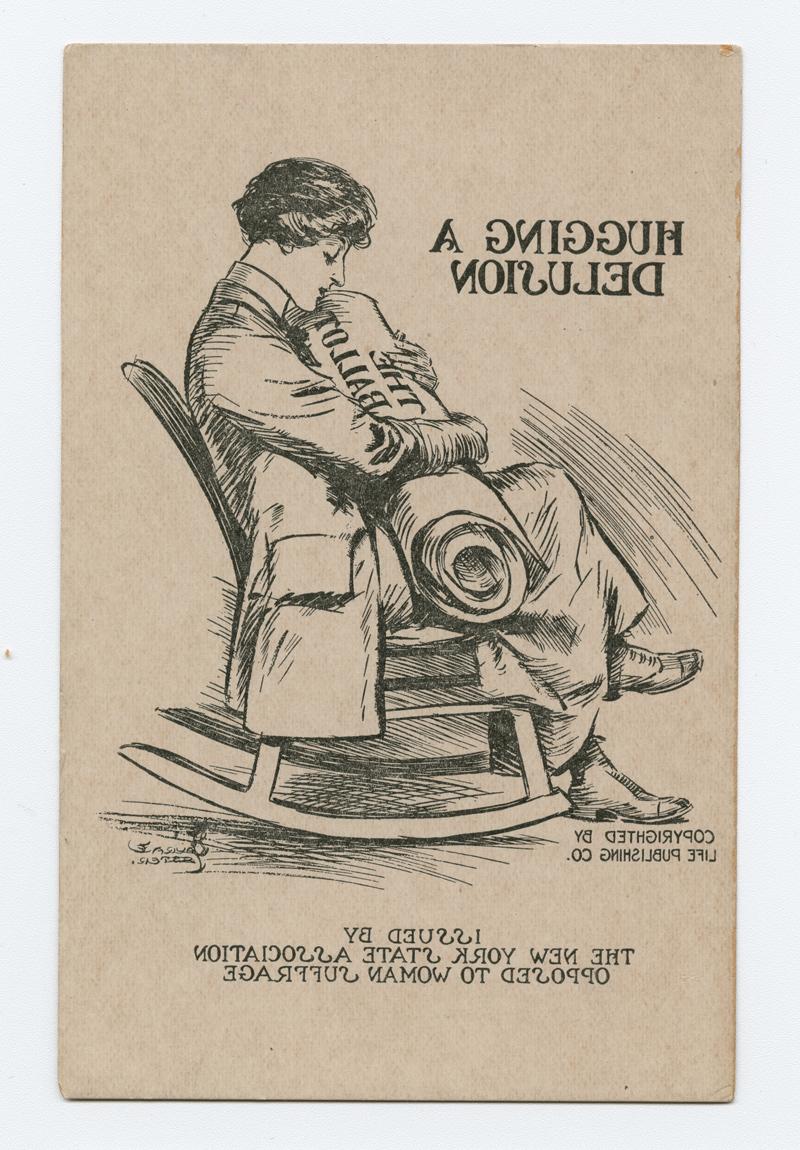
Hugging a Delusion. Postcard by Laura E. Foster, 1915
Commissioned in 1915 by Life magazine and distributed by the New York State Association Opposed to Woman Suffrage, this cartoon depicts a woman cradling a ballot in her arms. Entitled "Hugging a Delusion,这表明,投票并不能解决女性的所有问题,而且对女性来说,投票并不像做母亲那样令人满意. In the 1910s, artist Laura Foster designed illustrations both for and against women’s suffrage. As a professional artist, she produced work to support herself regardless of her own viewpoint
Learn more about the Suffrage movement in Massachusetts through our online web presentation, Massachusetts Debates a Woman's Right to Vote.
Voting by Mail
内战时期的漫画家和战地艺术家/记者描绘了1864年总统选举期间大量而热情的“士兵投票”. 1862年,一些北方州允许通过邮寄或代理投票,1864年,投票人数大大增加. By the time of World War I, most states had adopted civilian absentee voting as a progressive reform. However, few soldiers overseas were able to vote in 1918, and voting by mail was not an option for civilians during the influenza epidemic that year. 国会中的种族隔离主义者坚决反对为二战期间在海外服役的黑人士兵争取选举权, viewing it as a “state’s rights” issue and undermining a second great “soldier vote” in 1944.
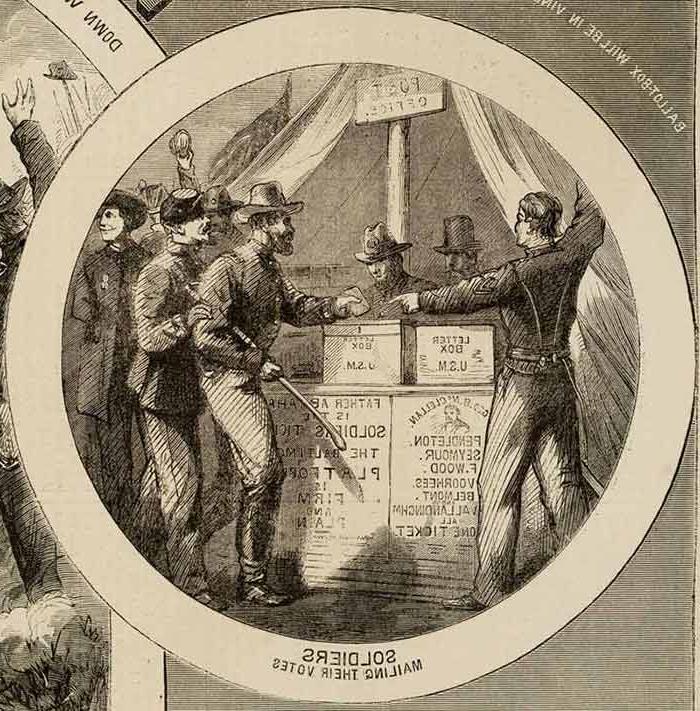
"Soldiers Mailing Their Votes." [Detail from "Election-Day. 8th November.'] Political cartoon, engraving by Thomas Nast
Thomas Nast’s celebration of the Republican Party’s election victory in 1864 (the “Union” ticket) shows, in a vignette within the engraving, soldiers casting their ballots by openly dropping them into “U.S.M[ail]” letter boxes.
1945年,比尔·莫尔丁(Bill Mauldin)凭借二战漫画获得了他的第一个普利策社论漫画奖. In his memoir, Up Front, 莫尔丁注意到,他og体育平台“士兵投票”的漫画是他在战争期间唯一一幅他认为是真正的社论漫画的画. While millions of soldiers voted by mail in 1944, southern legislators prevented Black soldiers from participating in the election.
More than six months ahead of the 2020 election, Tom Toles prophetically included a sign that read, "Notice: Post Office Out of Business," in a cartoon predicting potential problems with absentee voting.

"That’s Okay Joe…" Political cartoon by Bill Mauldin, 1944. Reproduced in Up Front in 1945. Courtesy, Bill Mauldin Estate, LLC.

TOLES © 2020 The Washington Post. Reprinted with permission of ANDREWS MCMEEL SYNDICATION. All rights reserved.
Attacking Limitations on Voting Rights
The Gerrymander
The Gerrymander by Elkanah Tisdale first appeared as a political cartoon in a Boston newspaper on March 26, 1812, and was quickly reprinted as a broadside with accompanying satirical verses. The Massachusetts legislature, controlled by Jeffersonian Republicans, had reapportioned state voting districts to favor their candidates. 他们的联邦党对手反击,在形状怪异的埃塞克斯县参议院选区地图上加上了翅膀, 把一个有效的政治策略变成了一个真正的怪物——一个以共和党州长命名的蝾螈状生物, Elbridge Gerry. Although the practice long preceded the term for it, “gerrymandering” is the gift of Massachusetts to the national—even international—political lexicon. Governor Gerry’s name, pronounced with a hard G, has been transformed into a soft G—“jerrymander.”
不公正划分选区的传说始于1812年联邦党政治领袖和新闻记者在波士顿的一次会议. 出于对杰斐逊派共和党对手通过改变选区来操纵州选举的不满,艺术家埃尔卡纳·蒂斯代尔在埃塞克斯县新参议院选区的轮廓地图上画上了一个头像和一对翅膀,并以杰斐逊派领袖的名字命名为“不公正的选区划分”, Gov. Elbridge Gerry. 而另一幅以埃塞克斯郡为背景的马萨诸塞州地图显示,按照现代的不公正划分选区的标准,该选区并没有畸形到令人难以接受的程度, the cartoon shocked the public and proved very effective.

His Excellency Elbridge Gerry LL.D. governor of Massachusetts. Mezzotint by John Rubens Smith, based on a painting by John Vanderlyn.
Is this the face that launched the manipulation of countless voting districts to gain political advantage? Some viewers see Elbridge Gerry’s craggy profile, in reverse of this image, under the wing of the monster in the Gerrymander cartoon.
Gov. Gerry, 他是《og体育官网》的签署人,因为宪法缺乏对个人自由的保护而拒绝签署, became a fiercely partisan Jeffersonian Republican. 不管他是这个计划的发起者是为了保护民主党的利益,还是只是以他的名字命名的法案的签名者, it offered him no statewide advantage, as he was defeated for reelection in 1812.
Explore Contemporary Connection
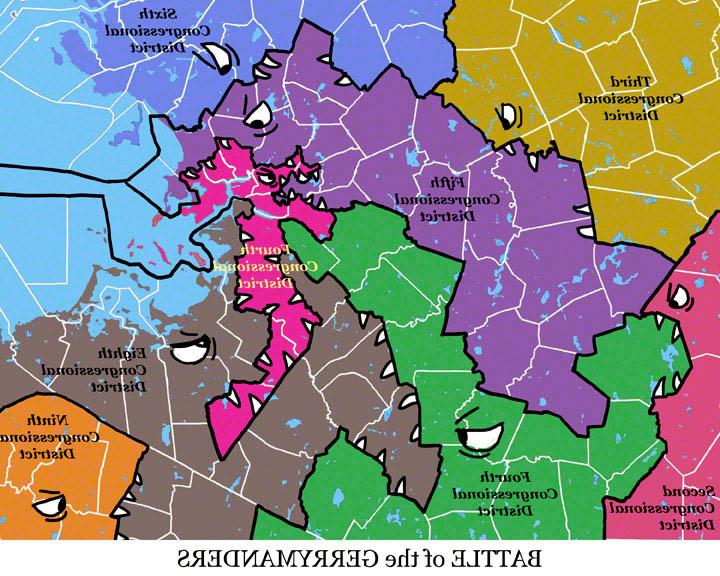
Battle of the Gerrymanders, by E. J. Barnes, 2020
Political Corruption: “In Counting There Is Strength.”
许多19世纪的漫画聚焦于政治腐败——塞满投票箱和贿选——作为投票权的障碍. Thomas Nast drew his most famous cartoons in the course of his sustained attack on the Tweed Ring, named for William Marcy Tweed, who ruled New York City from Tammany Hall. As caricatured by Nast, the Tweed Ring became the embodiment of political venality. He pictured “Boss” Tweed boldly leaning on a ballot box, which bears the inscription: “In counting there is strength.”
While Nast was based in New York, he drew for a national audience. There were Massachusetts political figures tarnished by corruption—Benjamin F. Butler in particular—who were too (un)appealing not to caricaturize. In his cartoons, Nast also called out the hypocrisy of liberal reformers including Charles Francis Adams, who was depicted as the iceberg upon which Massachusetts Democrats wrecked in 1876.
Explore Contemporary Connection
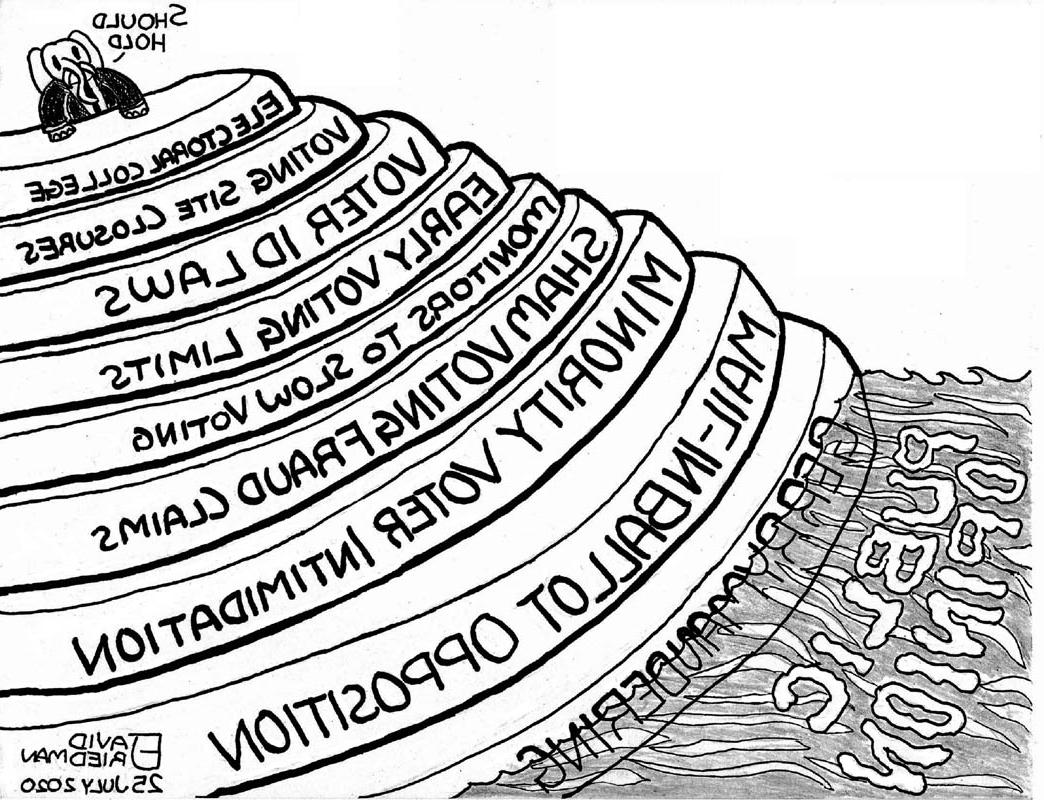
Tide of Opinion, by David Friedman, 2020
 "'That's What's the Matter.' Boss Tweed. 'As long as I count the Votes, what are you going to do about it? say?'"
"'That's What's the Matter.' Boss Tweed. 'As long as I count the Votes, what are you going to do about it? say?'"
 "The Tammany Tiger Loose--'What are you going to do about it?'"
"The Tammany Tiger Loose--'What are you going to do about it?'"
 "The Cradle of Liberty in Danger."
"The Cradle of Liberty in Danger."
 Two Old-Time Standard-Bearers of Public Morality.
Two Old-Time Standard-Bearers of Public Morality.
 "Struck--At Sea. If it had not been for that haze (Hayes), they could have steered clear of the iceberg."
"Struck--At Sea. If it had not been for that haze (Hayes), they could have steered clear of the iceberg."
The Electoral College
Until the contested results of the Hayes-Tilden presidential election in 1876, there were few early “Electoral College” cartoons. These cartoons, for the most part, do not address the role of the Electoral College in constraining voting rights. 漫画家们抗议的是政治欺诈,而不是将总统选举交给选举人“团”而不是人民普选的根本制度.
In more recent times, 社论漫画家赫布洛克回到了总统竞选期间选举团的话题. 他的漫画警告了选举团产生的选举结果可能与普选结果不一致的危险. Although there were some close calls, his prophetic warning came true in 2000 at the end of his long career, when George W. Bush, the winner of the electoral vote, defeated Albert Gore, who captured the popular vote.
 "Compromise—Indeed!"
"Compromise—Indeed!"
 "A National Game That is Played Out."
"A National Game That is Played Out."
 “Whew! Can’t We Find Some Other Route?”
“Whew! Can’t We Find Some Other Route?”
 I Don't Hold With Newfangled Ideas Like Democracy and a Yewnited States.
I Don't Hold With Newfangled Ideas Like Democracy and a Yewnited States.
Political cartoon by Herb Block, published 10 July 1979. A 1979 Herblock Cartoon, © The Herb Block Foundation  “很明显,大学录取有一个‘侧门’,一些人利用这个‘侧门’进入了他们没有挣到钱的大学."
“很明显,大学录取有一个‘侧门’,一些人利用这个‘侧门’进入了他们没有挣到钱的大学."
Political cartoon by Tom Toles, March 2019. TOLES © 2019 The Washington Post. Reprinted with permission of ANDREWS MCMEEL SYNDICATION. All rights reserved.
“Whew! Can’t We Find Some Other Route?”

In editorial cartoons dating back to the extremely close 1960 presidential election, Herblock prophesied political disaster if the electoral vote was at odds with the popular vote. 每隔四年,他都会对可能妨碍公平总统选举的负担和障碍提出警告, but always returned to the antiquated Electoral College system, portrayed here as a dinosaur blocking the tortuous path to the 1968 election.
I Don't Hold With Newfangled Ideas Like Democracy and a Yewnited States.

Herblock continued his crusade against the Electoral College throughout his long editorial career. In 1979,在总统竞选中,罗纳德·里根以压倒性的普选和选举团胜利告终, Block satirized voters who did not “Hold With Newfangled Ideas Like Democracy.”
“很明显,大学录取有一个‘侧门’,一些人利用这个‘侧门’进入了他们没有挣到钱的大学."

In March 2019, at the beginning of the present presidential campaign season, Tom Toles compared the Electoral College to revelations of cheating and bribery in college admissions. Presidential candidates were able to enter the White House, a place "they didn’t earn" by popular vote, through the side door of the Electoral College.


